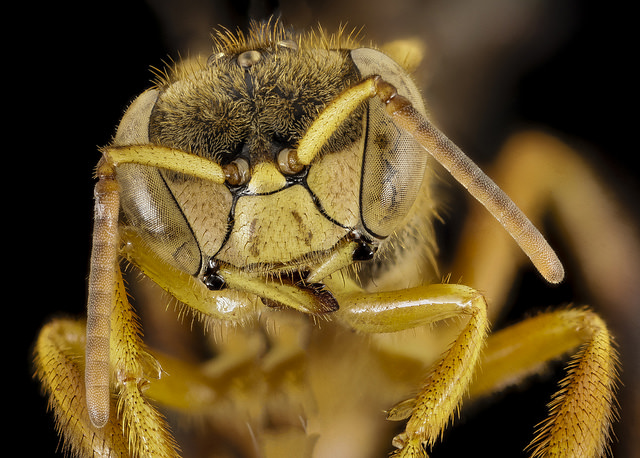Anaphylactic Shock (Anaphylaxis) — Symptoms and Treatment
Table of Contents
Image: “Stingless bee 1, f, face, peru_2014-07-30-12.33.22 ZS PMax” by USGS Bee Inventory and Monitoring Lab. License: Public Domain
Instant Recall: Type-I-Immediate-Type
Allergies are divided into four different types according to Coombs and Gell:
- Immediate-type allergic reaction,
- Cytotoxic-type allergic reaction,
- Immune complex-type allergic reaction,
- Delayed-type allergic reaction.
Anaphylactic shock belongs to the type 1 hypersensitivity: immediate-type allergy. Anaphylaxis is caused typically by:
- Food exposures (including nuts, eggs, soy, etc.)
- Insecticides
- Medication (metamizole, penicillin, NSAR)
- Infections
- Inhalation (pollen, latex, etc.)
The complex immunological reaction proceeds quickly. A “first exposure“ with the antigen occurs prior to an allergic reaction. The IgE-antibodies, which bind mast cells to surfaces, play an important role in this reaction. Once there is a second exposure to the same or similar allergen, the bound IgE-antibodies interlink with each other and lead to a degranulation of mast cells. This leads to the release of inflammatory mediators, especially histamine and prostaglandins, followed by vascular dilatation (which leads to a drop in blood pressure) and increase the permeability of the vessels (which leads to swelling).
Anaphylactic shock is the most severe form of the type 1 reaction. This leads to redistribution of blood volume in the peripheral circulation (distributive shock), with the reduced venous return and reduced cardiac output. This leads to decreased tissue perfusion and tissue hypoxia.
Anaphylactic Symptoms
Acute Therapy of Anaphylaxis
Treatment of anaphylactic shock includes:
- Recognize the condition early (this is critical)
- Remove or discontinue (in the case of medication or other agents) the offending allergen
- Administer oxygen via face mask
- Obtain adequate (i.e. large bore) venous access as soon as possible (needed to administer medications)
- Corticosteroids (e.g. prednisolone), and H1- and H2- antihistamines intravenously (high doses)
- Epinephrine (i.m. or i.v.)- patients may not have easy venous access when in shock.
- Intravenous crystalloids to maintain volume
- Fast-acting inhaled β2-sympathomimetic.
- Recognize that a GCS- score of < 8 requires endotracheal intubation for airway protection and oxygenation.
In Order to Avoid a Shock…
Desensitization: the specific immunotherapy (SIT) can be used for prophylactic sensitization to specific allergens, e.g. bee or wasp venom and certain types of pollen. A steady increase of the injected (subcutaneous or sublingual) antigen in minimal dosage can achieve a physiological rather than an excessive IgE-antibody-production. Especially younger patients with a monovalent allergy benefit from desensitization therapy.
Emergency-kit: Patients should learn to use and carry on them at all times, an emergency kit, including H1-antihistamine, glucocorticoid, and epinephrine.
Breast milk diet: reduction of developing atopic predisposition by exclusive breastfeeding during the first 4—6 months.
Stimulating climate: in the event of pollen allergies, a relocation is an extreme form of prophylaxis.

Comentários
Enviar um comentário